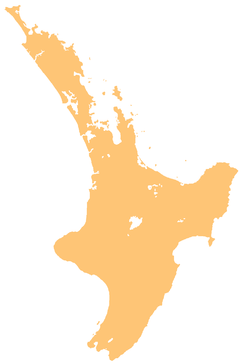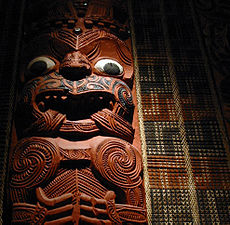- Thames, New Zealand
-
Thames Coordinates: 37°8′18″S 175°32′15″E / 37.13833°S 175.5375°E Country New Zealand Region Waikato District Thames-Coromandel District Population (2006) – Total 6,756 Thames
 i/ˈtɛmz/ is a town at the southwestern end of the Coromandel Peninsula in New Zealand's North Island. It is located on the Firth of Thames close to the mouth of the Waihou River, at 37°8′18″S 175°32′15″E / 37.13833°S 175.5375°ECoordinates: 37°8′18″S 175°32′15″E / 37.13833°S 175.5375°E. The town is the seat of the Thames-Coromandel District Council.
i/ˈtɛmz/ is a town at the southwestern end of the Coromandel Peninsula in New Zealand's North Island. It is located on the Firth of Thames close to the mouth of the Waihou River, at 37°8′18″S 175°32′15″E / 37.13833°S 175.5375°ECoordinates: 37°8′18″S 175°32′15″E / 37.13833°S 175.5375°E. The town is the seat of the Thames-Coromandel District Council.The Maori name for Thames is Hotereni. The Maori iwi are Ngati Maru, who are descendants of Marutuahu's son Te Ngako. Ngati Maru is part of the Ngati Marutuahu confederation of tribes or better known as Hauraki Iwi.
The town was initially built during a gold rush, the first major discovery of gold was made on August 10, 1867 by William Hunt, in the Kuranui Stream at the north end of Thames. The subsequent mine produced more than 102,353oz bullion and was known as the Shotover. The era from 1868 to 1871 were the bonanza years for the town with gold production topping one million pounds sterling at its peak. Official figures for production of the Thames Mines recorded a yield of 2,327,619oz bullion with the value at $845 million. The 3 richest fields were the Manukau / Golden Crown / Caledonian mines but many others yielded near equivalent amounts. Towards the end of the 19th century Thames was the largest centre of population in New Zealand with 18,000 inhabitants and well over 100 hotels and three theatres 1868. For a while it was thought it would replace Auckland as the major town in the area. A former local institution of learning was the Thames School of Mines. Thames also benefited from a period of extensive Kauri logging in the surrounding ranges around the same time.
Many people migrated to Thames at its peak, and it was soon the second-largest city in New Zealand (the largest being Dunedin then Auckland). However, as the gold began to diminish, so did the number of inhabitants, and although Thames never shrank, it has never grown much either. It is still the biggest town on the Coromandel. The population in the 2006 census was 6,756, an increase of 51 since 2001.[1] Many residents work in tourism and locally owned businesses servicing the local farming community.
Contents
History
Thames was formed from two historic towns, Grahamstown and Shortland, of which many original buildings still stand. Shortland was in the south of Thames and was founded on the 27th of July 1867 when James Mackay, civil commissioner for the Hauraki District concluded an agreement with local Maori. This agreement secured the rights to local mineral deposits leading to the proclamation of the Thames Goldfield on 1 August. Grahamstown was founded the following year at the northern end of present Thames, approximately one mile from Shortland. The two towns merged in 1874 after it emerged the heart of the Goldfield was in Grahamstown. Shortland waned in importance until the turn of the century when the Hauraki Plains were developed for farming and the Shortland railway station was opened.
The land involved in goldmining in Thames was Māori owned; important parts of the goldfield were owned by the Ngati Maru Rangatira (Chief) Rapana Maunganoa and the Taipari family. In 1878, when Wiremu Hōterene Taipari married a woman of the Ngāti Awa tribe of Whakatāne, Ngāti Awa carvers arrived at Thames and built a meeting house at Pārāwai it is incorrectly said to have been a wedding gift for the couple, when in actual fact Wiremu's father had paid money for another whare (meeting house), which was sold to the governor general at the time. So when Wiremu's father returned to collect the whare the Ngati Awa chief apologized and said he would have another one built which will signify the marriage between Wiremu Taipari and his daughter. The house, named Hotunui in honour of an important Ngāti Maru ancestor, now stands in the Auckland War Memorial Museum.
Thames Hospital is the oldest still operating in New Zealand, having been built in the 1860s. The maori owned land was gifted by the Ngati Maru Rangatira (chief) Rapana Maunganoa. A new clinical centre and other improvements were completed in 2008, and a new maternity facility is due for completion in 2010.[2]
Business
A major employer is the Toyota New Zealand plant, which assembled CKD cars until 1998, and now refurbishes imported used cars. Another is the precision engineering works and foundry of A & G Price, established 1868, who built 123 steam locomotives for New Zealand Railways Department.
The Kopu sawmill, a few km south of Thames, closed in 2008 with the loss of 145 jobs.[3][4]
The Brian Boru Hotel, built in 1868, is the oldest Irish pub in New Zealand.[5]
Education
Thames High School is a secondary (years 9-13) school with a decile rating of 6 and a roll of 647.[6] The school was established in 1880 and is the second oldest secondary school in the Auckland Province.[7]
Moanataiari, Parawai and Thames South are full primary (years 1-8) schools with decile ratings of 5, 6 and 3 and rolls of 114, 336 and 164, respectively.[8][9][10]
St Francis School is a full primary (years 1-8) school with a decile rating of 7 and a roll of 86.[11] It is a state integrated Catholic school[12]
All these schools are coeducational.
Born in Thames
- Kylie Bax - Model and Actress
- Sonny Parker - Welsh international rugby union player
- Lloyd Stephenson - Hockey player
- Bruce Purchase - British actor
- Air Chief Marshal Sir Keith Park - WW2 Air Commander and AOC 11 Group during Battle of Britain (July - October 1940)
Notes
- ^ The population is the sum of the statistical areas of Moanataiari (Quickstats about Moanataiari) and Parawai (Quickstats about Parawai)
- ^ "Thames Clinical Centre" (PDF). http://www.waikatodhb.govt.nz/file/fileid/10706. Retrieved 2009-02-16.
- ^ "Kopu mill to close, 145 jobs to be lost". The New Zealand Herald. 6 May 2008. http://www.nzherald.co.nz/section/1/story.cfm?c_id=1&objectid=10508334.
- ^ Gay, Edward (14 October 2008). "Small town 'devastated' at mass job losses". The New Zealand Herald. http://www.nzherald.co.nz/employment/news/article.cfm?c_id=11&objectid=10537431.
- ^ Ghost Hunt: True New Zealand Ghost Stories ISBN 0-7900-1012-7
- ^ "Te Kete Ipurangi - Thames High School". Ministry of Education. http://www.tki.org.nz/e/schools/display_school_info.php?school_id=111.
- ^ "About us". Thames High School. http://www.thames-high.school.nz/index.php?mid=1.
- ^ "Te Kete Ipurangi - Moanataiari School". Ministry of Education. http://www.tki.org.nz/e/schools/display_school_info.php?school_id=1829.
- ^ "Te Kete Ipurangi - Parawai School". Ministry of Education. http://www.tki.org.nz/e/schools/display_school_info.php?school_id=1886.
- ^ "Te Kete Ipurangi - Thames South School". Ministry of Education. http://www.tki.org.nz/e/schools/display_school_info.php?school_id=2027.
- ^ "Te Kete Ipurangi - St Francis School, Thames". Ministry of Education. http://www.tki.org.nz/e/schools/display_school_info.php?school_id=1945.
- ^ "Thames Parish". Coromandel Catholic Parishes. http://www.coromandelcatholic.org.nz/Thames/tabid/994/Default.aspx.
External links
Categories:- Populated places in New Zealand
- Thames-Coromandel District
Wikimedia Foundation. 2010.



